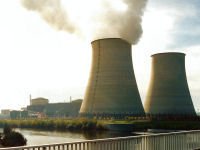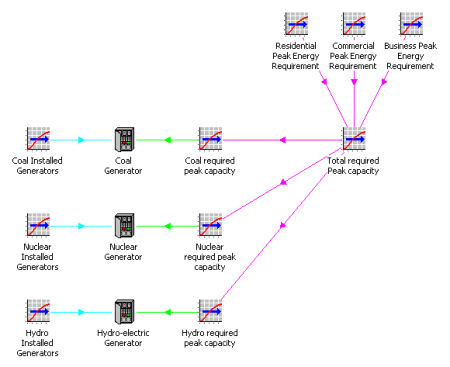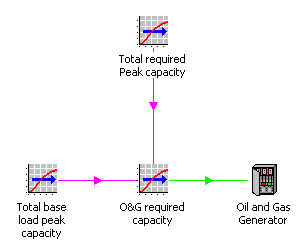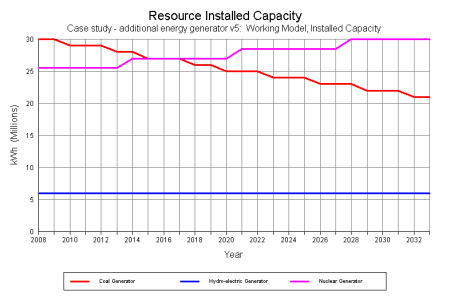 Outside
these periods, the lower level of demand on the grid (the base load) is
met as far as possible using less expensive sources of energy. Base-load power plants
are cheaper to run than O&G plants, but take a long time to start up and are
relatively inefficient at less than full output. These plants – typically nuclear
and coal-fired – run at all times throughout the year.
Outside
these periods, the lower level of demand on the grid (the base load) is
met as far as possible using less expensive sources of energy. Base-load power plants
are cheaper to run than O&G plants, but take a long time to start up and are
relatively inefficient at less than full output. These plants – typically nuclear
and coal-fired – run at all times throughout the year.
The long-term planning of the base-load power stations in the national grid must
be done carefully in order to minimise the use of O&G turbines, without over-building.
This article presents a basic STEM model that is able to forecast energy demand
and the requirements for O&G turbines. (Of course hydro-electric plant are commonly
used for peak production too, but our model focuses on the financial impact of the
significantly more expensive O&G turbines.)
Planned base-load generation and incremental peak capacity
The demand for energy comes from three major types of users: residential, commercial
and large businesses. These exhibit quite different patterns of demand, modelled
using the following assumptions for a typical industrialised country:
- Residential users mostly require energy during the morning and evening, every day
of the year, and have a low energy profile of around 15kWh per day per household.
- Commercial users require energy during working hours Monday to Friday, with a typical
energy consumption of 160kWh per working day per site.
- Large businesses (here assumed to be heavy consumers of energy) typically require
520GWh per day summed across the whole large business sector, and are able to smooth
their consumption over the whole day, every day of the year.
The following figure presents the STEM implementation of such demand.

Energy demand
Coal, Nuclear and Hydro resources are used to handle base-load energy generation
in this model (and other sources such as wind-powered generators could be added).
The number of base-load generators is not driven directly by the total peak capacity
required, but is instead determined by a long-term plan of the number of such generators.
This centrally planned approach is modelled by three ‘Installed generators’
transformations, one for each resource, as shown below. The peak requirement is
passed on to the resources, to enable cost allocation (which is not treated in this
article).

Base-load planning and peak requirements
Given the base-load capacity of the power grid as determined by the long-term planning
of base-load resources, the additional capacity required at peak times can be calculated:
this then drives the number of O&G turbines that must be installed, as shown
below. Note that these turbines have a 15-year lifetime, so once installed they
remain available even if base-load generation increases later.

Additional peak energy capacity
The supply of each type of generator is also modelled, and the associated capital
and operational costs can be estimated. In simple terms, coal plants require supplies
of coal and produce pollutants and greenhouse gases that entail further costs in
line with national legislation and ‘Kyoto’ pollution permits. Nuclear plants require
uranium and create radioactive waste that must be disposed of at some expense. Hydro-electric
plants do not require fuel supplies (apart from rain), nor do they create by-products.
Additional resources required include high-voltage transmission networks, low-voltage
distribution networks, and commercial and administrative overheads.
Optimising the mix of base-load and expensive peak generation
The model uses scenario planning to optimise the deployment of base-load generators
and minimise costs (typically driven by the build-out of O&G generators, and
the cost of oil and gas supplies), and also reduce the costs arising from pollution
(here modelled by pollution permits). Our base case (over 25 years) assumes the
following hypotheses, as illustrated in the figure below:
- Gradual phase out of coal generators
- Increase in amount of energy from nuclear sources over time, but not increasing
as fast as the decline in output due to the phasing out of coal
- Amount of energy from hydro-electric plants remains constant (assuming all suitable
dam locations have been used).

Assumed base-load energy generation (coal, nuclear, hydro)
These assumptions have two consequences. Looking first at the peak energy requirement
(below, left-hand graph), the peak demand modelled drives a significant consumption
of the O&G resources, with the amount of O&G-generated energy required gradually
decreasing over time.
However, looking at the annual energy supply the share taken by O&G
is only 1%, since O&G turbines are primarily used to provide ad-hoc peak supply
during the peak hour. The share of annual energy production by nuclear plants increases
steadily to reach 50%, while the proportion of energy generated from coal decreases
from 50% to around 35% in 25 years.

Peak and annual energy requirement and supply, by generator type
STEM can model energy supply and allocate costs for retail pricing
While the assumptions of this model can be modified for specific countries (or particular
energy providers), this case study demonstrates the ability of STEM to model energy
supply over long periods of time. Base-load planning can be optimised to minimise
the use of expensive sources of energy during peak periods.
The model can also explore the consequences of certain choices regarding social
benefits, such as pro-actively choosing low-emission energy sources (here nuclear
or hydro-electric plants, or wind turbines – not modelled here), and to examine
costs arising from pollution permits.
Distribution and overhead costs can also be included, allowing the model to calculate
end-to-end costs (allocated to each type of service and energy user on a per-kWh
basis). This cost allocation will become a useful tool if energy price regulation
evolves from the current RPI-X method to a cost-based method.